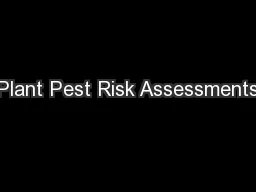

Regulation of Genetically Engineered Organisms at APHIS John Turner Director Environmental Risk Analysis Programs Regulation of GE products at USDA Law Plant Protection Act Regulation 7 CFR 340 ID: 727991
Download Presentation The PPT/PDF document "Plant Pest Risk Assessments" is the property of its rightful owner. Permission is granted to download and print the materials on this web site for personal, non-commercial use only, and to display it on your personal computer provided you do not modify the materials and that you retain all copyright notices contained in the materials. By downloading content from our website, you accept the terms of this agreement.
Slide1
Plant Pest Risk Assessments
Regulation of Genetically Engineered Organisms at APHIS
John Turner
Director
Environmental Risk Analysis ProgramsSlide2
Regulation of GE products at USDA
Law: Plant Protection Act
Regulation
: 7 CFR 340
We regulate if:
The organism has been altered or produced through genetic engineering (recombinant DNA techniques),
and
The organism poses a plant pest risk
Produced using plant pest sequences, or
There is otherwise a reason to believe it is a plant pestSlide3
Regulated Activities
If a GE organism is regulated, a
Permit
or
Notification
is required for the following activities:
Importation
Interstate movement
Field test (confined release)Slide4
Confined Field Tests
Field testing focuses primarily on confinement; a full data package on the GE trait is not needed.
Risk assessment relies on familiarity with the plant, the trait, and the environment.
Characteristics of the plant are often key:
Is it
outcrossing
of self-pollinating?
Is it weedy or invasive?
Can it persist after the test is over?
Would the trait be expected to change the plants
weediness
, invasiveness, or reproductive biology?Slide5
Petition Process for Nonregulated Status
After safety has been established through field testing and other research activities, a developer may petition APHIS to grant “
nonregulated
status”
No longer a regulated article
Free to be moved and planted without permits or further APHIS oversight.Slide6
Petition Process for Nonregulated Status
Petition Evaluation
Comprehensive
scientific
review – Team of scientists
Crop
biology and
taxonomy
Any genotypic differences
Any phenotypic differences
Field
test reports for all releases conducted in the U.S.
Relevant
experimental data, publications and other data upon which to base a determinationSlide7
Petition Procedure for Nonregulated Status
APHIS
BRS conducts two evaluations
:
Plant Pest Risk Assessment
to determine if the GE organism poses a risk as a plant pest (Plant Protection
Act)
Environmental Assessment or Environmental Impact Statement
to broader evaluate environmental impacts of APHIS-BRS decision (National
Environmental Policy Act; NEPA
)Slide8
Petition Process for Nonregulated Status
Components of a Plant Pest Risk Assessment:
Create pest or disease problems for agriculture.
Become a weed.
Increase the
weediness
of sexually compatible plants.
Harm non-target organisms (beneficial, endangered).
Affect agricultural practices in a way which could create disease and pest problems.
Transmit the genes to organisms with which it does not normally interbreed.Slide9
Corn –
HT, IR, AP
Soybean –
HT, PQ
Cotton –
HT, IR
Canola -
HT, AP,
PQ
Papaya –
VR
Squash –
VR
Tobacco –
PQ
Sugar beet –
HTAlfalfa – HTRose – AP
Tomato – PQChicory – APPotato - IR, VRRice – HTFlax – HTPlum – VR
HT – herbicide toleranceIR – insect resistanceAP – agronomic propertiesVR – virus resistancePQ – product quality
GE Plants with
Nonregulated StatusOver 90 Petitions Approved
In Production
Not in Commercial ProductionSlide10
Categories of Products
Reviewed many times over past 20 years
Corn, cotton, soy, canola
Herbicide resistance (mainly EPSPS and PAT) and insecticide resistance (
Bt
)
Highly familiar
Currently reviewing
New types of plants - Eucalyptus, apple, peanut
New traits - Disease resistance, cold tolerance, yield increased, drought tolerance, new groups of herbicidesSlide11
The Future
New Challenges
New types if plants
Biofuel crops, ability to grow on marginal lands, not agricultural,
some compatible compatible
with
wild species, chosen for prolific biomass
producion
Trees (Exotic or native)
New
less familiar traits
entire
metabolic
pathways
stress tolerance
altered metabolism
MicrobesControl plant pests and diseasesAlgae for biofuelsInsectsSynthetic organisms?Slide12
The Future
New Challenges
Increasing scale of modification
Production – moving out of “proof of principle” when familiarity is low and/or confinement appears challenging.
How much data is needed to predict the
weediness
, invasiveness, or other impacts of trees?
New technologies – are there novel risks associated with new technologies?
RNAi
(off target effects?)
Technologies using zinc finger nucleases,
meganucleases
, TALENS
Synthesis of chromosomes/genomes
Appropriate comparator for exotic organisms
Uncertainty
Risk vs benefitsSlide13
The Future
New Challenges
Unintended variability (Is the review of every event appropriate?)
Insertional
mutagenesis
Comparable to the potential for variation in other types of breeding? (and the selection for/against
)
Intactness of insert
Multiple reviews of same crop/trait? Slide14
Thank You